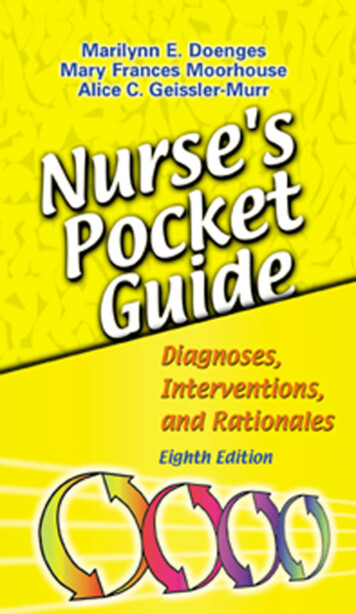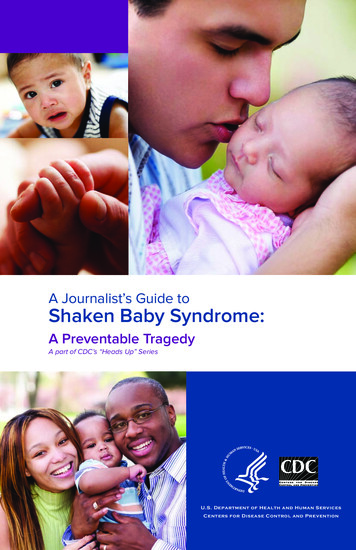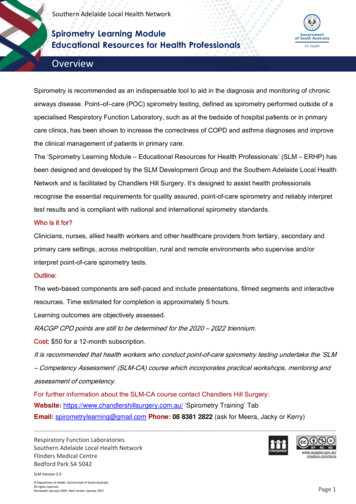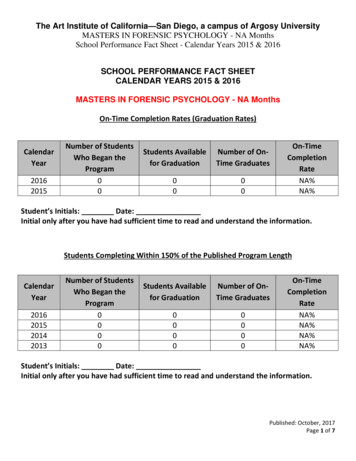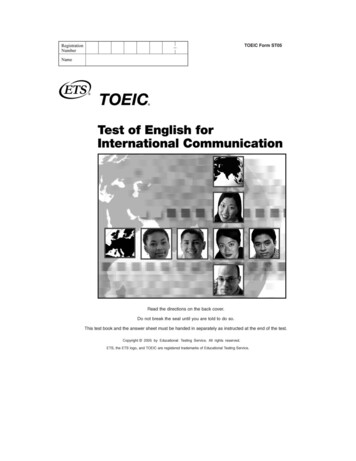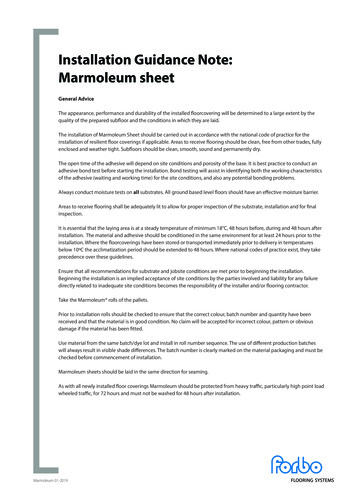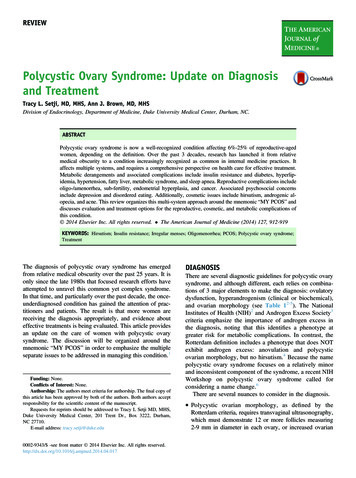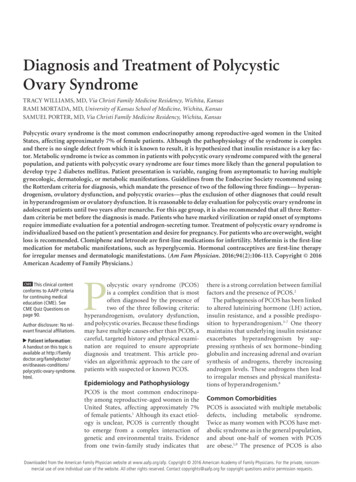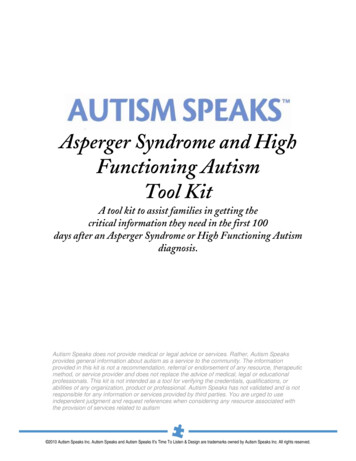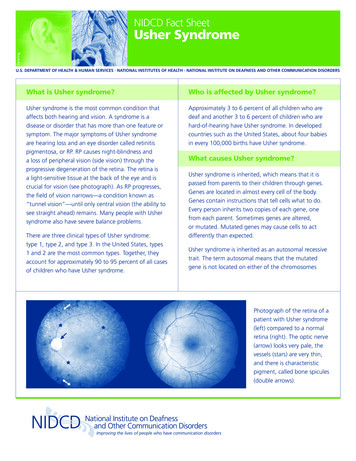
Transcription
NIDCD Fact SheetbalancehearingUsher Syndromeu.s. department of health & human services national institutes of health National Institute on Deafness and Other Communication DisordersWhat is Usher syndrome?Who is affected by Usher syndrome?Usher syndrome is the most common condition thataffects both hearing and vision. A syndrome is adisease or disorder that has more than one feature orsymptom. The major symptoms of Usher syndromeare hearing loss and an eye disorder called retinitispigmentosa, or RP. RP causes night-blindness anda loss of peripheral vision (side vision) through theprogressive degeneration of the retina. The retina isa light-sensitive tissue at the back of the eye and iscrucial for vision (see photograph). As RP progresses,the field of vision narrows—a condition known as“tunnel vision”—until only central vision (the ability tosee straight ahead) remains. Many people with Ushersyndrome also have severe balance problems.Approximately 3 to 6 percent of all children who aredeaf and another 3 to 6 percent of children who arehard-of-hearing have Usher syndrome. In developedcountries such as the United States, about four babiesin every 100,000 births have Usher syndrome.There are three clinical types of Usher syndrome:type 1, type 2, and type 3. In the United States, types1 and 2 are the most common types. Together, theyaccount for approximately 90 to 95 percent of all casesof children who have Usher syndrome.What causes Usher syndrome?Usher syndrome is inherited, which means that it ispassed from parents to their children through genes.Genes are located in almost every cell of the body.Genes contain instructions that tell cells what to do.Every person inherits two copies of each gene, onefrom each parent. Sometimes genes are altered,or mutated. Mutated genes may cause cells to actdifferently than expected.Usher syndrome is inherited as an autosomal recessivetrait. The term autosomal means that the mutatedgene is not located on either of the chromosomesPhotograph of the retina of apatient with Usher syndrome(left) compared to a normalretina (right). The optic nerve(arrow) looks very pale, thevessels (stars) are very thin,and there is characteristicpigment, called bone spicules(double arrows).
NIDCD Fact SheethearingbalanceUsher SyndromeChances of Inheriting aRecessive Disorderthat determine a person’s sex; in other words, bothmales and females can have the disorder and canpass it along to a child. The word recessive meansthat, to have Usher syndrome, a person must receivea mutated form of the Usher syndrome gene fromeach parent. If a child has a mutation in one Ushersyndrome gene but the other gene is normal, he orshe is predicted to have normal vision and hearing.People with a mutation in a gene that can cause anautosomal recessive disorder are called carriers becausethey “carry” the gene with a mutation, but show nosymptoms of the disorder. If both parents are carriersof a mutated gene for Usher syndrome, they will havea one-in-four chance of having a child with Ushersyndrome with each birth. (See sidebar on “Chancesof Inheriting a Recessive Disorder.”)Genetic disorders can be caused by one or morechanges in a gene. Every individual has two copiesof the same gene. Genetic disorders are inherited indifferent ways. Usher syndrome is a recessive disorder.Usually, parents who have normal hearing andvision do not know if they are carriers of an Ushersyndrome gene mutation. Currently, it is not possibleto determine whether a person who does not have afamily history of Usher syndrome is a carrier. Scientistsat the National Institute on Deafness and OtherCommunication Disorders are hoping to changethis, however, as they learn more about the genesresponsible for Usher syndrome.Recessive means: A person must inherit a change in the same genefrom each parent in order to have the disorder. A person with one changed gene does not havethe disorder, but can pass either the changed or theunchanged gene on to his or her child.An individual with Usher syndrome usually hasinherited a change in the same gene from each parent.An individual who has one changed Usher syndromegene is called a carrier. When two carriers of the sameUsher syndrome gene have a child together, with eachbirth there is a: 1-in-4 chance of having a child with Ushersyndrome. 2-in-4 chance of having a child who is a carrier. 1-in-4 chance of having a child who neither hasUsher syndrome nor is a carrier.What are the characteristics of the threetypes of Usher syndrome?Type 1Children with type 1 Usher syndrome are profoundlydeaf at birth and have severe balance problems.Many of these children obtain little or no benefit fromhearing aids. Parents should consult their doctor andother hearing health professionals as early as possibleto determine the best communication method fortheir child. Intervention should be introduced early,during the first few years of life, so that the child cantake advantage of the unique window of time during
Type 3Children with type 3 Usher syndrome have normalhearing at birth. Although most children with thedisorder have normal to near-normal balance, somemay develop balance problems later on. Hearing andsight worsen over time, but the rate at which theydecline can vary from person to person, even withinthe same family. A person with type 3 Usher syndromemay develop hearing loss by the teens, and he orshe will usually require hearing aids by mid- to lateadulthood. Night blindness usually begins sometimeduring puberty. Blind spots appear by the late teens toearly adulthood, and, by mid-adulthood, the person isusually legally blind.which the brain is most receptive to learning language,whether spoken or signed. If a child is diagnosed withtype 1 Usher syndrome early on, before he or she losesthe ability to see, that child is more likely to benefitfrom the full spectrum of intervention strategies thatcan help him or her participate more fully in life’sactivities.Because of the balance problems associated withtype 1 Usher syndrome, children with this disorder areslow to sit without support and typically don’t walkindependently before they are 18 months old. Thesechildren usually begin to develop vision problemsin early childhood, almost always by the time theyreach age 10. Vision problems most often begin withdifficulty seeing at night, but tend to progress rapidlyuntil the person is completely blind.The table at the bottom of the page is a summary ofthe characteristics of each type of Usher syndrome.Type 2Children with type 2 Usher syndrome are born withmoderate to severe hearing loss and normal balance.Although the severity of hearing loss varies, most ofthese children can benefit from hearing aids and cancommunicate orally. The vision problems intype 2 Usher syndrome tend to progress more slowlythan those in type 1, with the onset of RP often notapparent until the teens.Characteristics of Usher Syndrome, by TypeType 1Type 1Type 3HearingProfound deafness in both earsfrom birthModerate to severe hearingloss from birthNormal at birth; progressive loss inchildhood or early teensVisionDecreased night vision beforeage 10Decreased night vision beginsin late childhood or teensVaries in severity; night visionproblems often begin in teensVestibular function(balance)Balance problems from birthNormalNormal to near-normal, chance oflater problems
voice, speech, languagehearing, balancesmell, tasteHow is Usher syndrome diagnosed?Because Usher syndrome affects hearing, balance,and vision, diagnosis of the disorder usually includesthe evaluation of all three senses. Evaluation of theeyes may include a visual field test to measure aperson’s peripheral vision, an electroretinogram (ERG)to measure the electrical response of the eye’s lightsensitive cells, and a retinal examination to observethe retina and other structures in the back of the eye.A hearing (audiologic) evaluation measures how loudsounds at a range of frequencies need to be beforea person can hear them. An electronystagmogram(ENG) measures involuntary eye movements that couldsignify a balance problem.Early diagnosis of Usher syndrome is very important.The earlier that parents know whether their childhas Usher syndrome, the sooner that child can beginspecial educational training programs to manage theloss of hearing and vision.Is genetic testing for Usher syndromeavailable?So far, 11 genetic loci (a segment of chromosome onwhich a certain gene is located) have been found tocause Usher syndrome, and nine genes have beenpinpointed that cause the disorder. They are: Type 1 Usher syndrome: MY07A, USH1C, CDH23,PCDH15, SANS Type 2 Usher syndrome: USH2A, VLGR1, WHRN Type 3 Usher syndrome: USH3AsWith so many possible genes involved in Ushersyndrome, genetic tests for the disorder are notconducted on a widespread basis. Diagnosis of Ushersyndrome is usually performed through hearing,balance, and vision tests. Genetic testing for a fewNIDCD supports and conducts research and research training on thenormal and disordered processes of hearing, balance, smell, taste,voice, speech, and language and provides health information, basedupon scientific discovery, to the public.of the identified genes is clinically available. To learnabout laboratories that conduct clinical testing, visitthe Web site www.GeneTests.org and search thelaboratory directory by typing in the term “Ushersyndrome.” Genetic testing for additional Ushersyndrome genes may be available through clinicalresearch studies. To learn about clinical trials thatinclude genetic testing for Usher syndrome, visit theWeb site www.clinicaltrials.gov and type in the searchterm “Usher syndrome” or “Usher genetic testing.”How is Usher syndrome treated?Currently, there is no cure for Usher syndrome. Thebest treatment involves early identification so thateducational programs can begin as soon as possible.The exact nature of these programs will depend onthe severity of the hearing and vision loss as well asthe age and abilities of the person. Typically, treatmentwill include hearing aids, assistive listening devices,cochlear implants, or other communication methodssuch as American Sign Language; orientation andmobility training; and communication services andindependent-living training that may include Brailleinstruction, low-vision services, or auditory training.Some ophthalmologists believe that a high doseof vitamin A palmitate may slow, but not halt, theprogression of retinitis pigmentosa.This belief stemsfrom the results of a long-term clinical trial supportedby the National Eye Institute and the Foundationfor Fighting Blindness. Based on these findings, theresearchers recommend that most adult patients withthe common forms of RP take a daily supplementof 15,000 IU (international units) of vitamin A in thepalmitate form under the supervision of their eyecare professional. (Because people with type 1 Ushersyndrome did not take part in the study, high-dosevitamin A is not recommended for these patients.)
People who are considering taking vitamin A shoulddiscuss this treatment option with their health careprovider before proceeding. Other guidelines regardingthis treatment option include: Do not substitute vitamin A palmitate with a betacarotene supplement. Do not take vitamin A supplements greater than therecommended dose of 15,000 IU or modify yourdiet to select foods with high levels of vitamin A. Women who are considering pregnancy shouldstop taking the high-dose supplement of vitamin Athree months before trying to conceive due to theincreased risk of birth defects. Women who are pregnant should stop taking thehigh-dose supplement of vitamin A due to theincreased risk of birth defects.What are some of the latest researchfindings?NIDCD researchers, along with collaborators fromuniversities in New York and Israel, pinpointed amutation, named R245X, of the PCDH15 gene thataccounts for a large percentage of type 1 Ushersyndrome in today’s Ashkenazi Jewish population.(The term “Ashkenazi” describes Jewish people whooriginate from Eastern Europe.) Based on this finding,the researchers conclude that Ashkenazi Jewish infantswith bilateral, profound hearing loss who lack anotherknown mutation that causes hearing loss should bescreened for the R245X mutation.Where can I find more information?In addition, according to the same study, people withRP should avoid using supplements of more than 400IU of vitamin E per day.NIDCD maintains a directory of organizations that cananswer questions and provide printed or electronicinformation on Usher syndrome. Please see the list oforganizations at www.nidcd.nih.gov/directory.What research is being conducted onUsher syndrome?Use any of the following keywords to help you searchfor organizations that are relevant to Usher syndrome:Researchers are currently trying to identify all of thegenes that cause Usher syndrome and determine thefunction of those genes. This research will lead toimproved genetic counseling and early diagnosis, andmay eventually expand treatment options. Scientists also are developing mouse models thathave the same characteristics as the human types ofUsher syndrome. Mouse models will make it easierto determine the function of the genes involved inUsher syndrome. Other areas of study include theearly identification of children with Usher syndrome,treatment strategies such as the use of cochlearimplants for hearing loss, and intervention strategiesto help slow or stop the progression of RP.Usher syndromeHereditary hearing lossGenetic diseases/disordersDeaf-blindnessFor more information, additional addresses and phonenumbers, or a printed list of organizations, contact:NIDCD Information Clearinghouse1 Communication AvenueBethesda, MD 20892-3456Toll-free Voice: (800) 241-1044Toll-free TTY: (800) 241-1055Fax: (301) 770-8977E-mail: nidcdinfo@nidcd.nih.gov
voice, speech, languagesmell, tastehearing, balanceNIDCD supports and conducts research and research training on thenormal and disordered processes of hearing, balance, smell, taste,voice, speech, and language and provides health information, basedupon scientific discovery, to the public.NIDCD Fact Sheet: Usher SyndromePublication No. 98-4291Updated February 2008For more information, contact:NIDCD Information Clearinghouse1 Communication AvenueBethesda, MD 20892-3456Toll-free Voice:(800) 241–1044Toll-free TTY:(800) 241–1055Fax:(301) ww.nidcd.nih.govThe NIDCD Information Clearinghouse is a service of theNational Institute on Deafness and Other CommunicationDisorders, National Institutes of Health, U.S. Departmentof Health and Human Services.
such as American Sign Language; orientation and mobility training; and communication services and independent-living training that may include Braille instruction, low-vision services, or auditory trai

